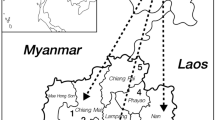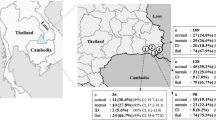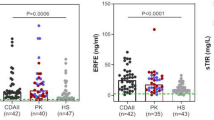Abstract
THE aborigines in Malaya form a distinct group of the Malayan population. They live more or less separated from the other groups and are genetically as well as socially entirely different from the group at present known as Malays. They are divided racially, according to WilliamHunt1, into the Negritos, the Senoi and the aboriginal Malays. The Senoi group is the largest and consists of many different sub-groups, of which the Temiar (or Temer), Semai and Temuan are the most important. Of the aboriginal Malays, the Jakun and the Semelai are the largest sub-groups. This classification is not universally accepted, but it forms a convenient basis for further discussions. Most of the aborigines live in the jungle, where the frequency of parasitic and tropical diseases is high and where infant mortality from malaria and dysentery is high.
This is a preview of subscription content, access via your institution
Access options
Subscribe to this journal
Receive 51 print issues and online access
$199.00 per year
only $3.90 per issue
Buy this article
- Purchase on Springer Link
- Instant access to full article PDF
Prices may be subject to local taxes which are calculated during checkout
Similar content being viewed by others
References
William-Hunt, P. D. R., An Introduction to Malayan Aborigines (Government Press, Kuala Lumpur, 1952).
Vella, F., Tenth Pacific Sci. Congr., Honolulu (August 1961).
Motulsky, A. G., and Campbell, J. M., Proc. Genet. Conf. Polymorphisms and Geographic Variations in Disease, edit. by Blumberg, B. S., 258 (1960).
Brewer, G. J., Tarlov, A. R., and Alving, A. S., J. Amer. Med. Assoc., 180, 386 (1962).
Beutler, E., J. Lab. and Clin. Med., 49, 84 (1957).
Smith, E. W., and Conley, C. L., Bull. Johns Hopkins Hosp., 93, 94 (1953).
Lie-Injo Luan Eng, Hæmoglobinopathies in East Asia. Seventh Intern. Congr. on Trop. Med. and Malaria. Rio de Janeiro (Sept. 1963).
Lie-Injo Luan Eng, and Poey-Oey Hoey Giok, Nature, 204, 88 (1964); Lie-Injo Luan Eng, and Chin, J. (in the press).
Allison, A. G., Nature, 186, 531 (1960). Allison, A. G., Askonas, B. A., Barnicot, N. A., Blumberg, B. S., and Krimbas, C., Ann. Human Genet., 26, 237 (1963). Bernini, L., Carcassi, U., Latte, B., Motulsky, A. G., Romei, L., and Siniscalco, M., Rec. Accad. Naz. dei Lincei., 19, 1 (1960).
Author information
Authors and Affiliations
Rights and permissions
About this article
Cite this article
LUAN ENG, LI., CHIN, J. Abnormal Hæmoglobin and Glucose-6-phosphate Dehydrogenase Deficiency in Malayan Aborigines. Nature 204, 291–292 (1964). https://doi.org/10.1038/204291a0
Published:
Issue Date:
DOI: https://doi.org/10.1038/204291a0
This article is cited by
-
Biochemical characteristics of glucose-6-phosphate dehydrogenase variants among the Malays of Singapore with report of a new non-deficient (Gd Singapore) and three deficient variants
Japanese Journal of Human Genetics (1991)
-
Glucose-6-phosphate dehydrogenase, reduced glutathione and heinz bodies in congenital haemolytic anaemia
The Indian Journal of Pediatrics (1976)
-
Haptoglobins, Transferrins and Serum Gamma-globulin Types in Malayan Aborigines
Nature (1967)
-
Hemoglobin E: Distribution and population dynamics
Human Genetics (1967)
-
Hereditary Ovalocytosis and Haemoglobin E-Ovalocytosis in Malayan Aborigines
Nature (1965)
Comments
By submitting a comment you agree to abide by our Terms and Community Guidelines. If you find something abusive or that does not comply with our terms or guidelines please flag it as inappropriate.



